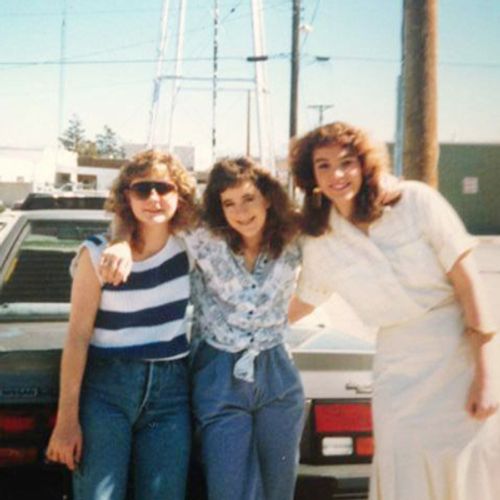Overview of Tara Calico
What could be more exhilarating than pedaling your bike down a familiar route; the wind in your hair and classic rock by the band Boston blasting in your ears as you race down the highway? 19-year-old University of New Mexico sophomore Tara Leigh Calico must have felt energized on her last bike ride on the morning of September 20, 1988 - the last day anyone ever saw her. This freewheeling image stands in stark contrast to the other side of Tara - the maker of daily to-do lists of everything she wanted to accomplish that day, who each morning laid out the clothes and belongings she'd need for the day and was generally organized to a fault. But Tara was both of these girls and so much more, to her mother Patty Doel, her stepdad John Doel, her biological dad David Calico, and her siblings.
Tara was a pretty, freckle-faced young woman who even as a child, was remarkably self-sufficient. At the tender age of 6, "Teeny Tara" as she was known affectionately by family, was making her own breakfast and taking care of her own needs, as well as the needs of others, without the slightest fuss. She was simply a natural leader and organizer; the type of kid who literally alphabetized the spice rack for fun. The product of a blended family - her mom and stepdad got married when Tara was 6 and had five children between them from previous marriages - Tara was Patty's youngest, but she made a big impact.
Tara juggled work, school, art projects, exercise, sports, family, and friends with seeming ease, working off her daily checklists and cramming as much activity into her day as she was able. She was very athletic, and typically rode her bike every day for exercise, frequently taking long rides with her mom. On that Tuesday morning, however, Tara set out alone at about 9:30 AM for her daily ride from their home on Brugg Drive in Rio Communities, a suburb of Belen, New Mexico, heading down NM Route 47. This was her standard route; she would ride 17 miles south down Route 47 to the train tracks, where she would turn around for the return trip. She had borrowed her mother's 12-speed neon pink Huffy mountain bike with yellow control cables and sidewalls because her own bicycle had a flat tire. Patty had recently stopped riding with Tara because she felt she may have been stalked by a motorist. But Tara was fearless and told her mom that if she wasn't back by noon to come get her. In addition to her regular two-hour bike ride, Tara had plans to play tennis with her boyfriend Jack Cole at 12:30 PM that day, and she was due at class at 4:00 PM at the University of New Mexico Valencia campus in Belen. She was an excellent student who was studying to become a psychiatrist or psychologist, in addition to holding a job at a local bank. As she set off on the 34-mile ride, she took her yellow sports-model Sony Walkman so she could listen to her favorite Boston tape as she rode. She was dressed in a typical casual outfit for 1988 - a white t-shirt with '1st National Bank of Belen' written on it, white shorts with green stripes, white ankle socks, and white and turquoise Avia tennis shoes. Some sources, however, indicate that Tara was reported as seen by witnesses wearing white shorts and a red top. She was also wearing a gold butterfly ring with a diamond insert, a gold amethyst ring, and small gold hoop earrings.
We know little about what happened to Tara after she set off in a southward direction down NM 47 at 9:30 AM. The next reported sighting of Tara was at 11:45 AM that morning, where she was spotted heading north on Highway 47 in Valencia County - apparently on her return trip - about two miles from her home. Seven witnesses confirmed seeing her at this time, but after that, she has never been seen again. These witnesses also reported seeing a dirty white or light "primer" gray 1953, 1955, or 1956 (sources vary) Ford pickup truck with a white handmade camper shell following Tara during her ride. Multiple witnesses confirmed that this vehicle was driving very slowly, about 40 feet behind Tara on her bicycle. One of the witnesses, Ishmael De La Rosa, provided an exact description of the middle-aged, Caucasian man with the bright reddish-brown hair behind the wheel. He also noted a set of pressed khaki shirts hanging in the back of the truck, the type of shirt a member of law enforcement would wear. However, it cannot be confirmed whether this truck is connected to her presumed abduction or not. It was reported that she was apparently unaware of the truck's presence, as she pedaled along with her headphones on, oblivious to any danger.
When her daughter did not arrive home by noon as expected, Patty Doel went out to look for her at 12:05 PM as she had promised. Unfortunately, she found no sign of Tara. She returned home and by now, Jack, who had called the house to confirm the tennis date and learned his girlfriend had not returned, had come to help with the search and brought his friend Bernard Nixon. Tara's stepfather John Doel also joined in the efforts to retrace Tara's path that morning. Nixon set off on a bike, while Jack, John, and Patty drove the route. They spoke with three men repairing a fencepost who recalled seeing Tara. They entered the John F. Kennedy campground about 19 miles away and saw three men in a dirty white or light gray truck, who claimed not to have seen Tara. When Patty came home at around 3:00 PM, she called hospitals and contacted the Valencia County Sheriff's office. Within 8 hours, Tara's information was entered into NCIC. Law enforcement also returned to the JFK campground with Patty and noted that while the truck was still there, it had moved. Police, family, and friends continued to search until 2:00 AM. To make matters worse, rain and windy weather moved in around 8:00 PM that evening, washing away any obvious signs - such as tire tracks - of what may have happened to her. The next day, Patty resumed her search and found a discarded Boston tape cassette in the mud on the south shoulder of NM 47 - the opposite side of the highway from where Tara had last been spotted - along with two sets of bike tracks, indicating the bike was possibly dragged. Also recovered on September 21 during the multiple searches conducted were a small, cracked plastic window belonging to a Sony Walkman, an Old Milwaukee beer can, and a piece of plastic that looked like a bike reflector. All were located near the JFK campground, and Patty believed that Tara was discarding some of these items as "breadcrumbs" to mark her trail. Ground searches continued for a week and a half, but air searches were called off due to heavy storms in the area. Search personnel included multiple branches of law enforcement (both county, local PD, and state PD), as well as military personnel and hundreds of volunteers, all of whom found nothing indicating the whereabouts of Tara. Additionally, the bike Tara was riding has never been found.
As there were many people around the day Tara vanished, multiple witnesses were interviewed by police, including De La Rosa. He came to the police's attention when he discovered that the woman he noticed biking ahead of the primer gray Ford pickup was reported missing, and called the Valencia County Sheriff's office and asked to speak to Captain Ray Flores. However, Flores seemed reluctant to take his statement. Eventually, he did, and under hypnosis, De La Rosa picked a man out of the photo lineup as the driver of the truck. Flores arranged a meeting for the next day but never showed up, and didn't respond to De La Rosa's attempts to follow up. In fact, De La Rosa heard nothing from Flores until July of 1989, when Flores asked for his help in creating a composite sketch. The sketch released in August of 1989 reveals a Caucasian male between 35-40 years of age, 5'9"-6' in height, 190-210 lbs with reddish-brown hair and blue or hazel eyes, with two deep wrinkles between the eyes and temple. At the time the composite is finally released, the truck is described as having a camper shell and bearing a New Mexico license plate starting with WBY or WBZ and 6 as the last digit. While giving the description that led to the composite, De La Rosa also mentioned that his friend Jack Aguayo's grandson, JJ Aguayo (who also goes by JJ Hampton), was hunting in the area that day with friends and saw Tara ride by. Jack confided to De La Rosa that he thought JJ and his friend Paul Zeiler, among others, may have been involved in Tara's disappearance and potentially had access to a truck similar to the one reported as following Tara. Jack further stated that his grandson and friends were involved with drugs. Police interview both Zeiler and Aguayo/Hampton, and note some inconsistencies in their accounts. Specifically, Zieler does not recall Aguayo/Hampton shooting at a Quality Homes sign along Route 47 that day, and does not recall seeing Tara that day. Aguayo/Hampton confirms he shot at the sign, and that they saw Tara riding her bike that day on Route 47. At a later date, a woman involved with JJ said that he told her he "felt bad about Tara" but he couldn't do anything, because the Sheriff's son, Lawrence Romero, Jr., was involved. Lawrence Romero, Sr. had successfully run for Sheriff in 1974, and he and Ray Flores led Tara's missing persons investigation. His son, Romero, Jr., the same age as Tara, was a known drug user and sometime dealer. Rumor had it that he had asked Tara out, but she turned him down due to having a boyfriend. In 1991, Romero, Jr. died as either a result of an intentional suicide or from a game of Russian Roulette gone terribly wrong. However, Romero, Sr. claimed it was a homicide.
About ten months after Tara vanished, on June 15, 1989, a woman in Port St. Joe, Florida was in the parking lot of Junior's convenience store when she noticed a white Toyota cargo van with no windows driven by a white male with a mustache. When she emerged from the store the van was gone, but face down in the parking spot was a Polaroid picture. She retrieved the photo and became alarmed. The Polaroid depicted a young woman in her late teens or early 20s and a young boy inside a van, both in apparent distress. Their hands were behind their backs as if they were bound, and they had duct tape across their mouths. The woman was wearing shorts and had long, bare legs, and next to her was a copy of the book "My Sweet Audrina" by V.C. Andrews an immensely popular author at that time. On the spine of the book was written what looked like a phone number. The woman turned the disturbing photo into the police, and it was featured in a story on the television show "A Current Affair". A friend of Tara's stepdad John Doel who happened to be watching thought it looked like Tara and alerted the Doels. At the same time, another family recognized the young boy in the photo as Michael Henley, who went missing a few months before Tara on April 21, 1988, in the Zuni Mountains of New Mexico while camping with his family. Both families flew to Florida to try and identify the children in the photograph, and both sets of parents were positive it was their child. Tara's mother pointed out the scar on the girl's leg which exactly matched one Tara had as a result of a car accident and noted that "My Sweet Audrina" was one of Tara's favorite books, by her most beloved author. The phone number on the spine was only partially legible but police tried every combination of numbers they possibly could, with no result. Witnesses reported that the girl in the photo was seen walking along a beach in Port St. Joe shortly before the Polaroid was found. This girl seemed to be following verbal orders given by three adult white males as they walked along.
Eventually, three investigative agencies would analyze the photo and reach three different conclusions. Scotland Yard confirmed that the girl in the Polaroid was indeed Tara, the Los Alamos National Laboratory debunked that theory and stated it was not Tara, and the FBI said that the results of their investigation were inconclusive. Theories that supported the idea that the Polaroid was a hoax included the fact that the girl's legs were shaved, which would indicate she was not a kidnap victim, and that the skin around the duct tape on the victim's mouths should have been redder and more irritated than it appeared, indicating the photo was staged. It was also noted that the shoulders of both of the individuals in the photo look too relaxed to be have been bound. Eventually, two other photographs allegedly connected to Tara's case would surface. The first was found near a construction site in Montecito, CA, and depicted a woman with tape over her mouth with a blue and white striped fabric background similar to the first Polaroid. The second photo showed a woman and man on an Amtrak train, the woman loosely bound in gauze and wearing large black-framed eyeglasses, with her eyes covered in gauze. It has never been officially confirmed that it was Tara in either of these photographs, but all three - especially the first Polaroid - remain linked to Tara's case forever. Patty Doel was reported as saying the photo had given her hope that Tara was still alive, and she spent the remainder of her days searching for her beloved daughter. In 1991, she and her husband John Doel were even formally deputized in order to be permitted to carry a weapon, conduct searches, and afford more access to case files and information to assist in their investigation into Tara's disappearance.
Sadly, Michael Henley's story ended in tragedy when it was determined the boy in the Polaroid could not have been him. The child's remains were found in June of 1990, just a few miles from the campsite where he was last seen in the Zuni Mountains. He was identified by dental records and foul play was ruled out, as the cause of death was believed to be hypothermia. It is suspected that he simply wandered off, became disoriented, and died of exposure.
There have been multiple developments in the case in the 30+ years since Tara vanished. After the discovery of the Polaroid and subsequent photos, the case seemed to go cold. It wasn't for lack of media exposure; Patty and John Doel, told their story on “Oprah,” “America’s Most Wanted,” “Unsolved Mysteries” and other news outlets, mailed out thousands of fliers, contacted hundreds of law enforcement agencies, and even entertained tips by psychics, hoping to garner information about their daughter's whereabouts. While some leads emerged, nothing led to an arrest. Fifteen years and thousands of investigative tips after Tara vanished, the Doels reluctantly moved to their retirement dream home in Port Charlotte, FL in November of 2003. On May 11, 2006, Patty Doel's mission to find her daughter ended when she passed away at the age of 64, never learning the truth about what happened to Tara. Tara's biological father, David Calico, had preceded Patty in death in 2002.
In 2008, Rene Rivera - who had worked the case since 1996 and had since become Sheriff - announced that he knew exactly what had happened to Tara, but those involved were too well-connected at the time to be touched. He stated that two men, local teenagers who knew Tara, accidentally hit her bike and panicked. They drove off with Tara, raped and killed her, tossing her bike in a Belen junkyard. Rivera stated that two other men were involved after the murder and helped dispose of Tara's body, allegedly throwing it in a pond or disposing of it elsewhere. He implied that they came from prominent families who helped in the cover-up and disposal of the body. He backpedaled a bit when questioned why no arrests had been made, citing the fact that they wanted to build an airtight case before publicly announcing any suspects. Shockingly, he made this announcement with no intention of following up until Tara's bike, clothing or body had been recovered, which angered John Doel. He did not understand why the Sheriff would make such an announcement without having solid evidence. That same year, Melinda Esquibel received a copy of the article in which Rivera was quoted about the case of a family member. Esquibel, a former classmate of Tara's and now a filmmaker, sought justice for Tara and began shooting a documentary about her in 2010 but had to cease production due to receiving death threats. She eventually launched a 34-episode podcast in 2017 - "VANISHED: The Tara Calico Investigation" - that is considered to be the seminal source of information about Tara's case. In 2018, she revisited the idea of a documentary about Tara's disappearance and began filming.
Two more disturbing photos came to light the year following Rivera's announcement. The Port St. Joe police chief David Barnes received two letters originating from Albuquerque - one postmarked in June and one in August of 2009. The first letter contained a photocopy of a picture of a young boy with his mouth blacked out in an attempt to look like the boy in the famous Polaroid of 1989. The second letter contained the original image of the boy, and The Star Newspaper in Port St. Joe also received the letter and a photocopy of the image.
After being quite stagnant since 2008, Tara's case was reopened in October of 2013 after a cold case Task Force was created to attempt to solve Tara's case, along with other cold cases. A report was taken by this task force from a former Valencia County Sheriff's Deputy named Frank Methola, detailing a deathbed confession years earlier by a man named Henry Brown who claimed to have information about Tara's case. Sources vary as to whether this statement was provided on April 15, 2010, or back in 2006. In the 2013 report, Methola told authorities that Brown, who was in his 80s at the time of the statement, had only wanted to "get something off his chest" and make sure he did everything he could to help authorities find Tara. He revealed that his neighbor Lawrence Romero, Jr. had shown him a makeshift basement under his mobile home, where he thought he had spotted a shallow grave wrapped in a blue tarp. Brown told them that Romero, Jr. and several friends had openly discussed killing Tara at the time she went missing. They all knew Tara, who they said had recently broken up with another friend of theirs, Jeff Abeyta. Allegedly, Romero, Jr., a man named Dave Silva, another man named Leroy Chavez, and an unnamed redheaded man were in a pickup truck when they spotted Tara riding along on her bicycle. They hit her with the truck - it's not clear whether it was accidental or on purpose - abducted her to some nearby gravel pits and raped her. When Tara - who was not the type to stay silent about such an attack - threatened to go to the police, Romero, Jr. stabbed her to death while the other men held her down. They then disposed of her body in a pond near the redhead's house, dumping her bike in a junkyard. A few years later, Brown noticed that Romero, Jr. had poured concrete over the basement and said that he had threatened to kill him if Brown alerted authorities, which was why he had waited until he was near death to come forward. At the time the murder occurred Romero, Jr.'s father was the Valencia County Sheriff, Lawrence Romero, who Brown alleged helped cover up the crime.
However, there is an actual transcript of a 2006 incident report taken by Deputy Methola as read by Melinda Esquibel in the "VANISHED: the Tara Calico Investigation" podcast. In this, Henry Brown's statement differs considerably from the one provided by Deputy Methola in 2013, which has been posted and widely discussed on the internet. In the 2006 report, the neighbor was actually referenced as someone with the initials AJ and there was no involvement by Romero, Jr. or the others mentioned. The incident report was taken after Brown called police because of a swarm of bees on his property which he believed to be caused by his neighbor, who was only referenced by the initials AJ. The police confirmed they couldn't do anything about the issue, but Brown then asked if he could reveal something that had been bothering him for 20 years. He went on to state that in November of 1988, his neighbor AJ showed him a makeshift basement under his home, with what looked like a shallow grave. AJ was apparently drunk and started talking about how Tara Calico went missing, and what a pretty girl Tara was. Years later, Brown noticed that AJ had covered the basement with a slab of concrete. AJ threatened to kill Brown if he went to the police or mentioned what they had talked about that night, and in 2001, he actually sent an armed gunman to Brown's home in an apparent but unsuccessful attempt to kill him. Brown, 83 at the time of the statement to Deputy Methola, said he just wanted to make sure he did everything he could to help authorities find Tara.
Sources report that in 2018, the FBI and the Valencia County Sheriff's Office announced that they had a new theory about what happened to Tara after two informants provided them with new information and that they were actively seeking two different living suspects. Once again, they were targeting two men who were teenagers at the time of Tara's disappearance. Authorities believed that Tara was attacked and killed by these boys when their pickup truck encountered Tara riding her bike on Route 47, and two other accomplices helped hide the evidence after the crime occurred. As in the earlier theory, it is surmised that the boys’ parents may have helped cover up the crime.
In 2019, the FBI offered a reward of $20,000 to anyone with information leading to the whereabouts of Tara Calico. Sources do not mention what prompted this new activity by authorities to reinvestigate the case. However, in September 2021, a statement was issued by the Valencia County Sheriff's Office and the New Mexico State Police indicating that there was a new lead in the case, and a sealed warrant for an unknown private residence located within the county had been issued. No further details were available at this time.
In 2023, the Valencia County Sheriff's Department announced they have a suspect in Tara's disappearance. They believe they have sufficient evidence to submit to the District Attorney's office for review of potential charges.




















































































































































